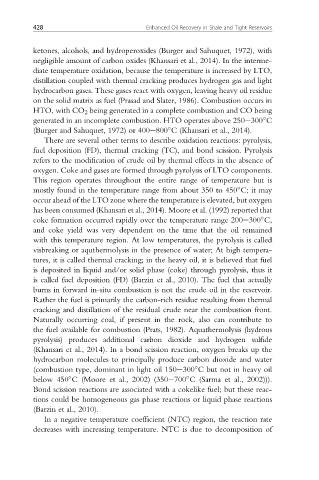Page 461 - Enhanced Oil Recovery in Shale and Tight Reservoirs
P. 461
428 Enhanced Oil Recovery in Shale and Tight Reservoirs
ketones, alcohols, and hydroperoxides (Burger and Sahuquet, 1972), with
negligible amount of carbon oxides (Khansari et al., 2014). In the interme-
diate temperature oxidation, because the temperature is increased by LTO,
distillation coupled with thermal cracking produces hydrogen gas and light
hydrocarbon gases. These gases react with oxygen, leaving heavy oil residue
on the solid matrix as fuel (Prasad and Slater, 1986). Combustion occurs in
HTO, with CO 2 being generated in a complete combustion and CO being
generated in an incomplete combustion. HTO operates above 250e300 C
(Burger and Sahuquet, 1972) or 400e800 C (Khansari et al., 2014).
There are several other terms to describe oxidation reactions: pyrolysis,
fuel deposition (FD), thermal cracking (TC), and bond scission. Pyrolysis
refers to the modification of crude oil by thermal effects in the absence of
oxygen. Coke and gases are formed through pyrolysis of LTO components.
This region operates throughout the entire range of temperature but is
mostly found in the temperature range from about 350 to 450 C; it may
occur ahead of the LTO zone where the temperature is elevated, but oxygen
has been consumed (Khansari et al., 2014). Moore et al. (1992) reported that
coke formation occurred rapidly over the temperature range 200e300 C,
and coke yield was very dependent on the time that the oil remained
with this temperature region. At low temperatures, the pyrolysis is called
visbreaking or aquthermolysis in the presence of water; At high tempera-
tures, it is called thermal cracking; in the heavy oil, it is believed that fuel
is deposited in liquid and/or solid phase (coke) through pyrolysis, thus it
is called fuel deposition (FD) (Barzin et al., 2010). The fuel that actually
burns in forward in-situ combustion is not the crude oil in the reservoir.
Rather the fuel is primarily the carbon-rich residue resulting from thermal
cracking and distillation of the residual crude near the combustion front.
Naturally occurring coal, if present in the rock, also can contribute to
the fuel available for combustion (Prats, 1982). Aquathermolysis (hydrous
pyrolysis) produces additional carbon dioxide and hydrogen sulfide
(Khansari et al., 2014). In a bond scission reaction, oxygen breaks up the
hydrocarbon molecules to principally produce carbon dioxide and water
(combustion type, dominant in light oil 150e300 C but not in heavy oil
below 450 C (Moore et al., 2002) (350e700 C (Sarma et al., 2002))).
Bond scission reactions are associated with a cokelike fuel; but these reac-
tions could be homogeneous gas phase reactions or liquid phase reactions
(Barzin et al., 2010).
In a negative temperature coefficient (NTC) region, the reaction rate
decreases with increasing temperature. NTC is due to decomposition of

